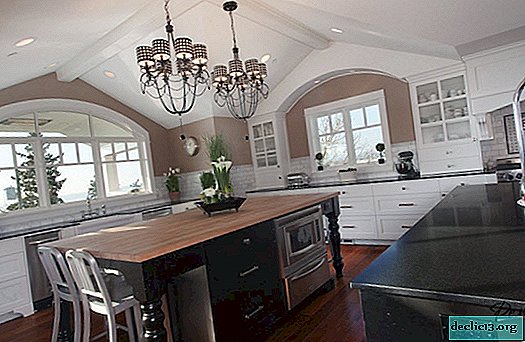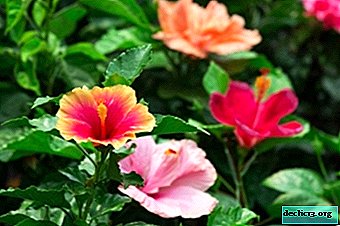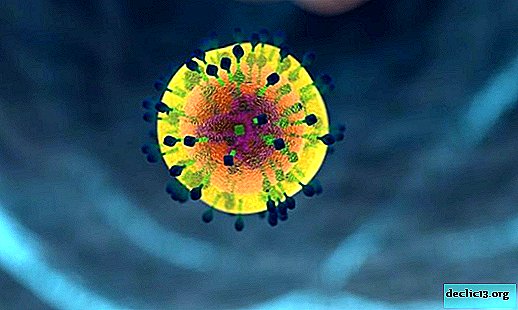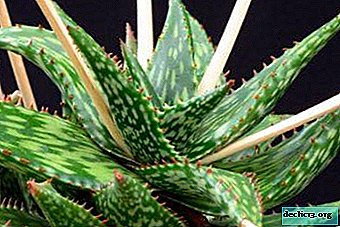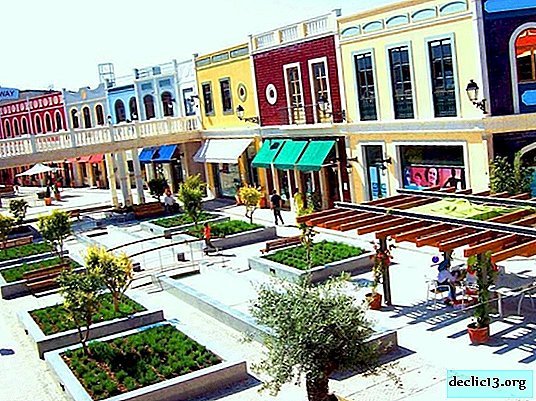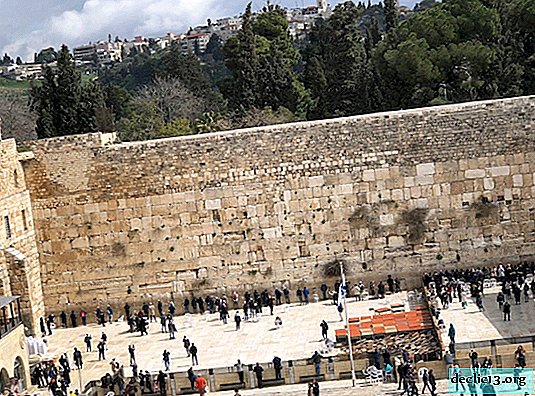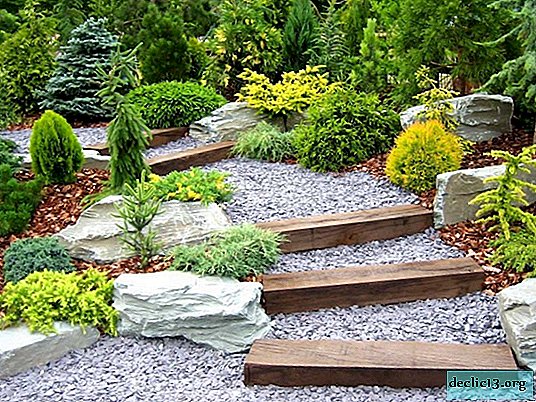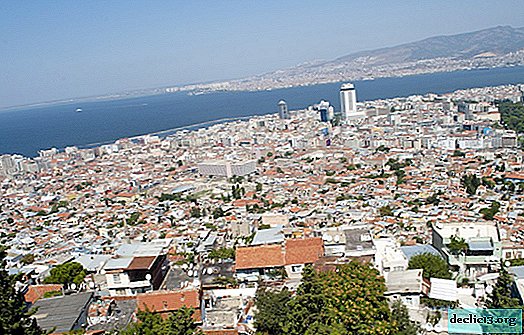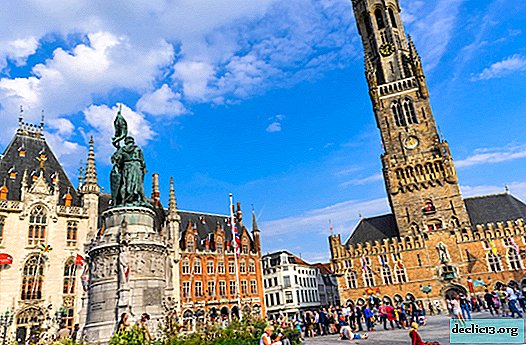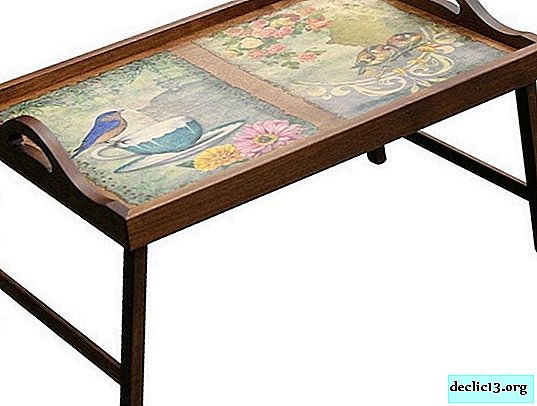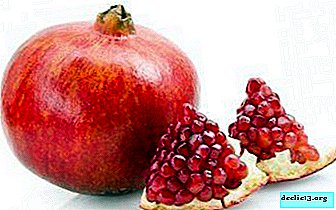What is the difference between garden pelargonium from geranium, what is the peculiarity of its cultivation?
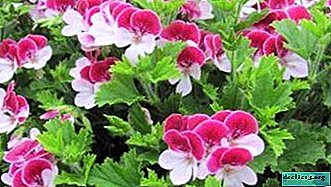
Usually, geranium is grown in the garden - a perennial cold-resistant plant, which also belongs to the geranium family, as well as pelargonium. But for the summer, thermophilic pelargonium with its decorative umbrellas and openwork leaves is planted in the garden. About the types of this beautiful flower, the features of cultivation, reproduction and care, we will describe in detail in this article. It will also be useful to watch an informative video on this topic.
Botanical description and history, price
Pelargonium refers to perennial herbaceous plants in which the stems and leaves are different, depending on the species. There are more than two hundred species of pelargonium, and thousands of varieties. In nature, pelargonium grows in Africa; it was introduced to Europe in the 17th century.
For a century and a half this plant was called geranium and only at the end of the 18th century, having allocated it as a separate genus of the geranium family, they began to call pelargonium. But until now, many thermophilic pelargonium is called geranium, which, on the contrary, is frost-resistant. For faster breeding in flower shops, you can purchase:
- rooted cuttings - from 50 rubles. per pc;
- adult flowering bush - from 250 rubles. per pc
External characteristics of the flower
The decorative qualities of pelargonium are influenced by its qualities:
- stems (depending on the type) are straight and branched, as well as creeping;
- leaves can be of the usual form - simple or openwork: palmate, palmate-dissected;
- their color is green or motley;
- when touched, the leaves emit a peculiar aroma;
- flowers in the form of lush umbrella-shaped inflorescences have a variety of colors, except for blue.
Common types and photos of plants
Pelargonium is bred both as a houseplant and as a garden plant.. The most popular are three garden views:
- zonal or hybrid garden (Pelargonium zonale);
- condyle, thyroid, or creeping (Pelargonium peltatum);
- large-flowered, English, royal or home (Pelargonium grandiflorum).
Zonal street

Zonal pelargonium is a perennial plant that is grown in the garden as an annual. This is the most common type of pelargonium, which includes more than a thousand varieties. Plant height depends on the variety and can vary from 15 cm to one and a half meters. The name is associated with horseshoe-shaped stripes on the leaves, repeating their shape, - zones (from the Greek zona - belt). Flowering is plentiful and relatively long. Popular varieties of zonal pelargonium have simple, semi-double and double terry inflorescences of different colors.
We wrote more about zonal pelargonium in this article.
Ivy

This is a grassy ampel plant with long, thin and hanging or creeping shoots. The leaves are similar to ivy leaves, which led to the name of this type of pelargonium. Bright flowers of medium size, collected 8-15 pieces in umbrella-shaped inflorescences, have a diverse color. They can bloom year-round. Pelargonium has an ability to cleanse itselfwhen the dried flowers fall away themselves, they do not have to be cut off.
You will find all the details about the ampel beauty here, and in this article we have described all types and care for the ivy pelargonium.
Large flowered

The height of the bush of some varieties can reach two to three meters and they need support. Thin stems woody at the base. The leaves are jagged bright green. Flowers of some varieties reach a diameter of 8 cm. Continuous flowering is possible for about nine months.
We will tell you about all types of such a wonderful plant as pelargonium in a separate article.
Rules and advice: where and how to plant it?
Before planting pelargonium in the garden, you must:
- prepare planting material;
- choose a place for landing;
- equip landing pits.
Planting material
Pelargonium is usually planted in the garden in early June., using, most often, cuttings from the shoots of existing plants. How to prepare the cuttings:
- it is better to take young green shoots;
- leaves and peduncle (if any) to remove;
- but leave a couple of leaves on top;
- on average, the length of the cuttings is 5 cm;
- cutting angle should be sharp;
- treat with charcoal (activated or wood);
- within three hours, the slices must be dried.
Rooting cuttings can be in water and then planted in the ground, you can - immediately in the ground.
The rules of rooting in water:
- add charcoal (activated) to the tank with ordinary water;
- keep the container in a bright, warm room, changing the water every two to three days.
Growing place
 Since pelargonium is a thermophilic plant, the place for it should be sunny and protected from the wind. The root system of pelargonium rots from waterloggingtherefore, there should be no stagnant water in this area.
Since pelargonium is a thermophilic plant, the place for it should be sunny and protected from the wind. The root system of pelargonium rots from waterloggingtherefore, there should be no stagnant water in this area.
At the bottom of the pit, drainage must be done using, for example, broken brick, gravel or small stones. Pour the soil mixture from the ground, peat and rotted compost from above.
Having placed the seedling in the planting pit, the soil around it should be slightly compacted. Then water and mulch the soil from drying out.
IMPORTANT: Mulching is the sprinkling of soil with organic mulch - dry peat, wood chips, bark, compost.Lighting
The main rule in the cultivation of pelargonium - the brightness and abundance of flowering depends on the sun. If there is a lot of direct sunlight in the area where pelargonium grows, the color of the flowers will be more vivid. It blooms and being in partial shade, but the inflorescences will be less bright on more elongated stems.
Land requirements
The main requirement for soil when growing pelargonium is that it should be light, well-permeable, without stagnation, which is detrimental to the roots.
How to care?
Pelargonium, like geranium, does not require special care. As a rule, it includes:
- watering;
- top dressing;
- pruning.
Watering
Pelargonium tolerates dryness well, and from waterlogging can get sick. Watering is needed moderate and regular. For the root system, the main condition for health is low humidity.
Top dressing
Affects the duration and abundance of flowering. When and what nutrition is needed:
- Liquid mineral fertilizers with a maximum of phosphorus and a minimum of nitrogen - during the period of active growth. Before applying liquid fertilizer, in order not to burn the roots, the plant should be watered.
- Potassium - necessary for abundant flowering.
- Fertilizers can be bought at a flower shop; instructions are always attached; You can use rotted compost.
Pruning
Thanks to cropping:
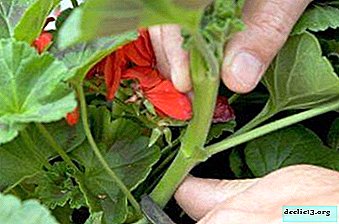 a bush with a compact crown is formed;
a bush with a compact crown is formed;- more buds of inflorescences appear;
- affected parts of the plant are removed;
- high-quality planting material is created.
To form a lush bush by increasing the number of side shoots, pinching should be applied. Important. Tweezing (pinching or pinching) is the procedure for removing the apex in young shoots. Removing wilted flowers contributes to flowering. In the fall, before the onset of frost, pelargonium must be transplanted into pots and placed in a warm room.
Major diseases and pests
In order for pelargonium to grow and bloom normally, you need to follow simple rules:
- to land her in a sunny area;
- remember that for its roots it is harmful to be in waterlogged soil.
Possible consequences for violation of care standards:
- the leaves dry at the edges, the stems are exposed from below - with a lack of lighting;
- turn yellow, and then fall off - in violation of the irrigation regime;
- brown spots appear on the leaves, gray rot - infection with a fungus.
The appearance of black root rot becomes detrimental to the plant, it is not treated and the bush is recommended to be destroyed so that the infection does not threaten others. In all other cases, it is enough:
- remove the affected parts of pelargonium;
- provide proper watering and lighting;
- treat the plant with fungicides (with gray rot on the leaves or stem).
The main pests of pelargonium are:
- aphid;
- ticks;
- whitefly;
- caterpillars.
Caterpillars from plants must be collected manually, and the remaining pests are destroyed using insecticides.
Propagation Features
Pelargonium can be propagated using:
- division of the bush;
- cuttings;
- seeds.
Cuttings of pelargonium
The simplest thing is to carefully separate an adult plant and plant its parts separately. More often propagated by cuttings, using their own planting material obtained from young shoots of the plant. The cutting process is described in detail in this article above. Pelargonium can be propagated not only vegetatively (by cuttings), it can also be grown from seeds.
Watch the video about the cuttings of pelargonium:
Seed propagation
Important factors during seed propagation:
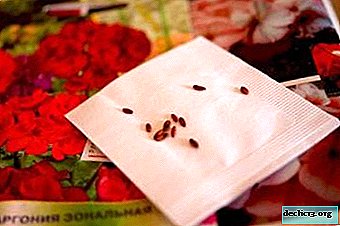 Sowing time. The best period for sowing is from the end of January and during February, when additional lighting is not required.
Sowing time. The best period for sowing is from the end of January and during February, when additional lighting is not required.- Seed selection. The appearance of healthy seeds should be like this - large, dense and oblong brown in color with a matte finish.
- Soil preparation. You can make a mixture of 1 part peat, 1 part sand and 2 parts land, you can use purchased soil. Within 2-3 minutes, the soil or the prepared mixture must be calcined, for example, in the oven.
- Temperature mode. If you grow seedlings at a temperature of no more than 18 degrees, it will not stretch up. It is considered optimal - no higher than 22 degrees.
- Landing process:
- Seeds should be planted at a distance of 5 cm from each other.
- Pour on them a layer of earth about 2 millimeters.
- Water with a spray gun.
- Cover the box with seeds with foil.
- Their daily ventilation is necessary.
- After about two weeks, the film must be removed (after emergence).
- When 2-4 leaves are formed, seedlings must be dived.
Watch the video about sowing pelargonium seeds:
Conclusion
A pick is a transplant of seedlings into a larger container. In decorative floriculture, pelargonium plays a huge role. It has bright, spectacular inflorescences, long and abundant flowering, beautifully shaped leaves and colors. At the same time, it multiplies easily and is unpretentious in care.

 a bush with a compact crown is formed;
a bush with a compact crown is formed; Sowing time. The best period for sowing is from the end of January and during February, when additional lighting is not required.
Sowing time. The best period for sowing is from the end of January and during February, when additional lighting is not required.
